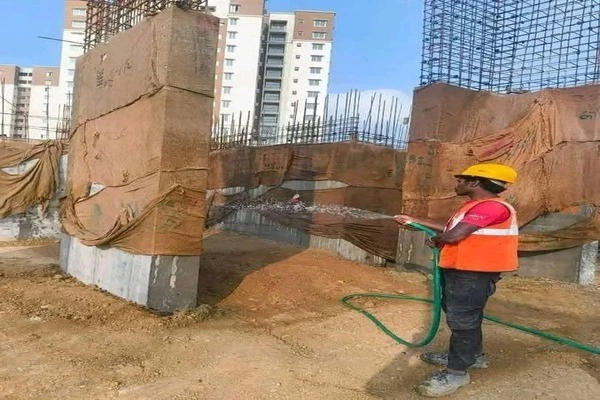Curing of Concrete is an important process that ensures concrete reaches its full strength and durability by maintaining proper moisture and temperature after placement.
As water is essential to the hydration process taking place within the concrete, keeping it moist helps it retain, or, if necessary, absorb the additional moisture it needs to complete the hydration, setting, and hardening process.
Furthermore, Concrete doesn’t reach its designed strength the moment it hardens. Its strength develops gradually as the cement continues to hydrate.
This hydration process needs adequate moisture, temperature, and time – and that’s exactly what curing provides.
Without proper curing, even the best-designed concrete will:
- Lose up to 50% of its strength,
- Develop shrinkage cracks,
- Become less durable, and
- Fail earlier under service conditions.
In other words, Curing is the life-support system of fresh concrete.
Moreover, it is vital to cure concrete properly in the first three days to increase its early strength development, long-term strength, impermeability and durability.
Ideally, it should then be kept in conditions of controlled temperature and humidity. In practical terms, this is achieved by several methods, depending on the situation:
- Periodically spray the concrete surface with water.
- Where possible, flooding or ‘ponding’ the entire surface – sometimes it may be necessary to build earth or clay dams around the area being cured.
- Covering the surface with wet sand.
- Cover the surface with waterproof paper or polythene to retain the moisture.
Recommended Articles
Table of Contents
Why is the curing of concrete essential?
Curing of concrete is essential because:
- Ensures Strength Gain – Continuous hydration helps concrete achieve its designed compressive strength.
- Improves Durability – Proper curing prevents surface scaling, dusting, and long-term deterioration.
- Reduce cracking – Good moisture retention prevents rapid drying, which can cause cracks in the structure.
- Enhances Resistance – Makes concrete more resistant to chemical attacks, abrasion, and freeze-thaw cycles.
Methods of Curing of Concrete

1. Water curing:
- The most common and effective method.
- Done by ponding, spraying, or covering with wet hessian cloth.
- Keeps the concrete continuously moist.
2. Membrane Curing:
- Spraying curing compounds (liquid membranes) to seal surface moisture.
- Best for large exposed surfaces such as pavements, highways, and runways.
3. Steam Curing:
- Used in precast concrete plants.
- Provides both heat and moisture to accelerate early strength gain.
4. Covering with Wet Materials:
- Using wet burlap, sand, straw, or hessian cloth.
- A low-cost traditional method is used on-site.
Selecting the Method of Curing of Concrete
The factors which affect the selection of a curing method include:
- The type of structural member to be cured, e.g. slab, column, beams, staircase, wall, etc..
- The specified finish for the concrete structure.
- Whether the curing process will influence the appearance of the concrete structure.
- The construction schedule for the project, e.g. will work need to continue in the area during the curing period.
- The cost and availability of materials, e.g. is water for curing available, and how much will the sprays and supervision cost?
- Weather conditions, exposure and location of the site.
⏱️Duration of Curing of Concrete
- Normal Concrete (OPC) → Minimum duration is 7 days.
- Blended Cement Concrete (PPC, PSC, etc.) → minimum duration is 14 days.
- Ideal Practice → 28 days of curing ensures maximum hydration and high performance.
Please note: In hot or windy climates, curing must start immediately to prevent rapid water loss.
✨ Final Thought On Curing of Concrete
Curing may look like a “small step” on site, but in reality, it is the backbone of concrete strength and durability. Neglecting it means investing in failure. “A well-cured concrete structure will outlive the builder – that’s the power of curing.”
Mind you, proper curing is an essential step in ensuring that the concrete structure is strong, durable, and attractive.
Neglecting this step can result in a range of negative consequences that can harm both the homeowner and the contractor.
To ensure the best possible outcome, it is recommended to use a high-quality cure as described above.
That’s all.
Join the conversation by replying on Bluesky.
If you liked this article, please join WebsiteForEngineers on Twitter, Facebook, TrueSocial, Pinterest, BlueSky, and in our WhatsApp channels.

